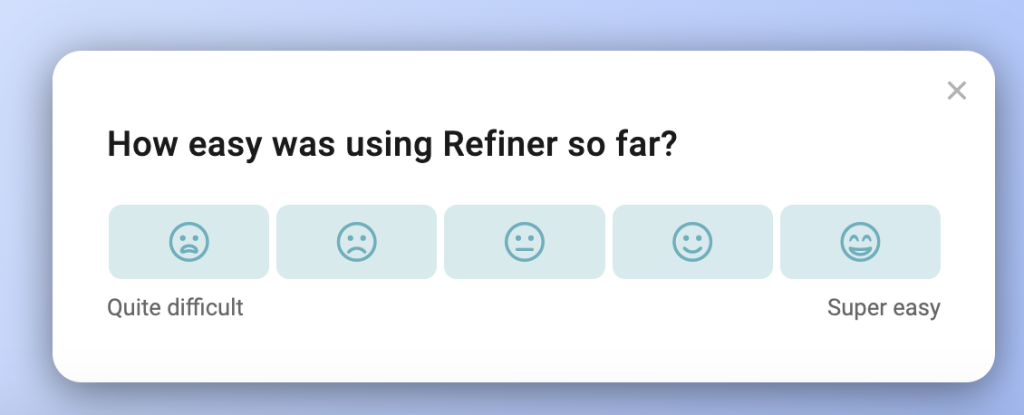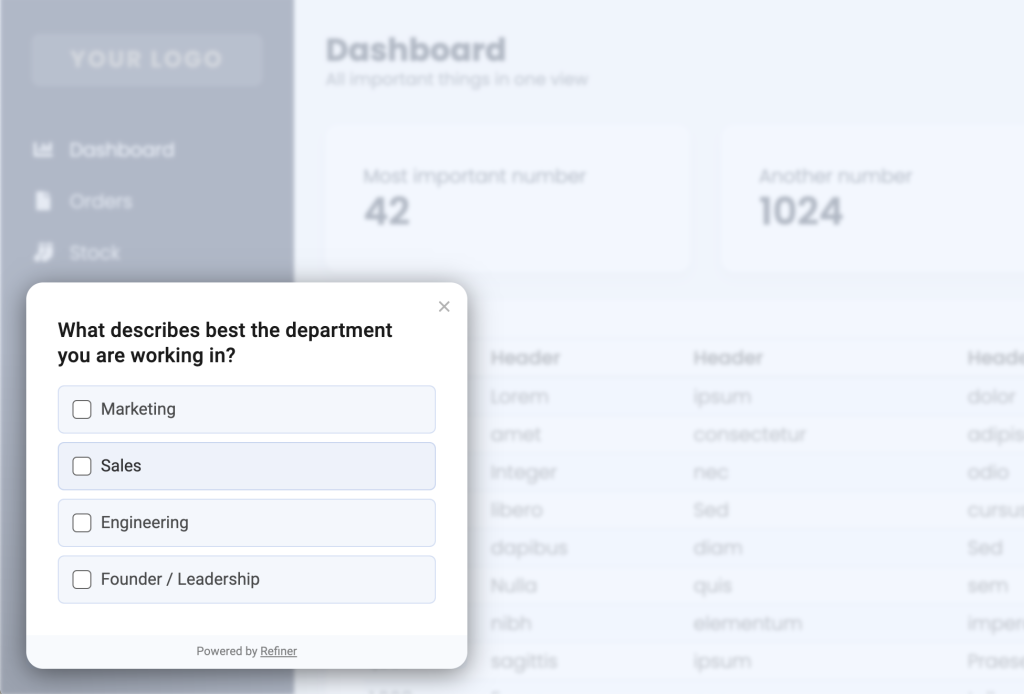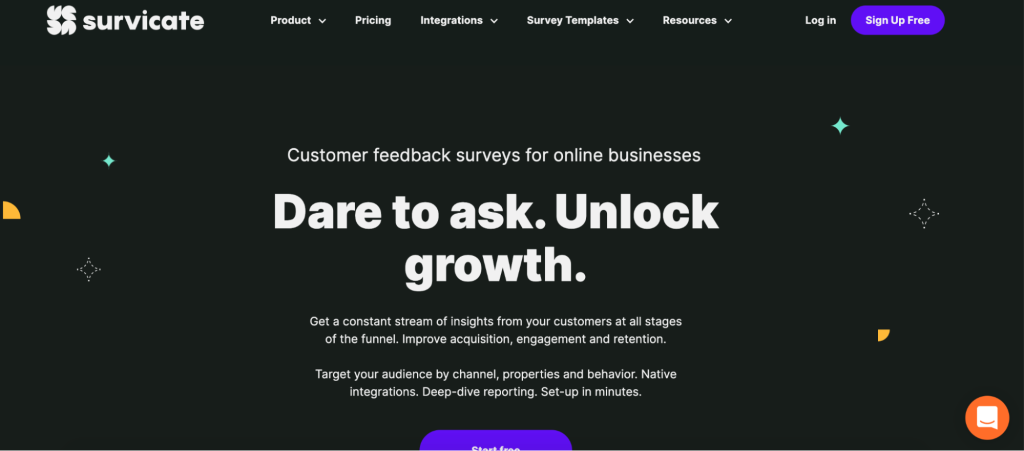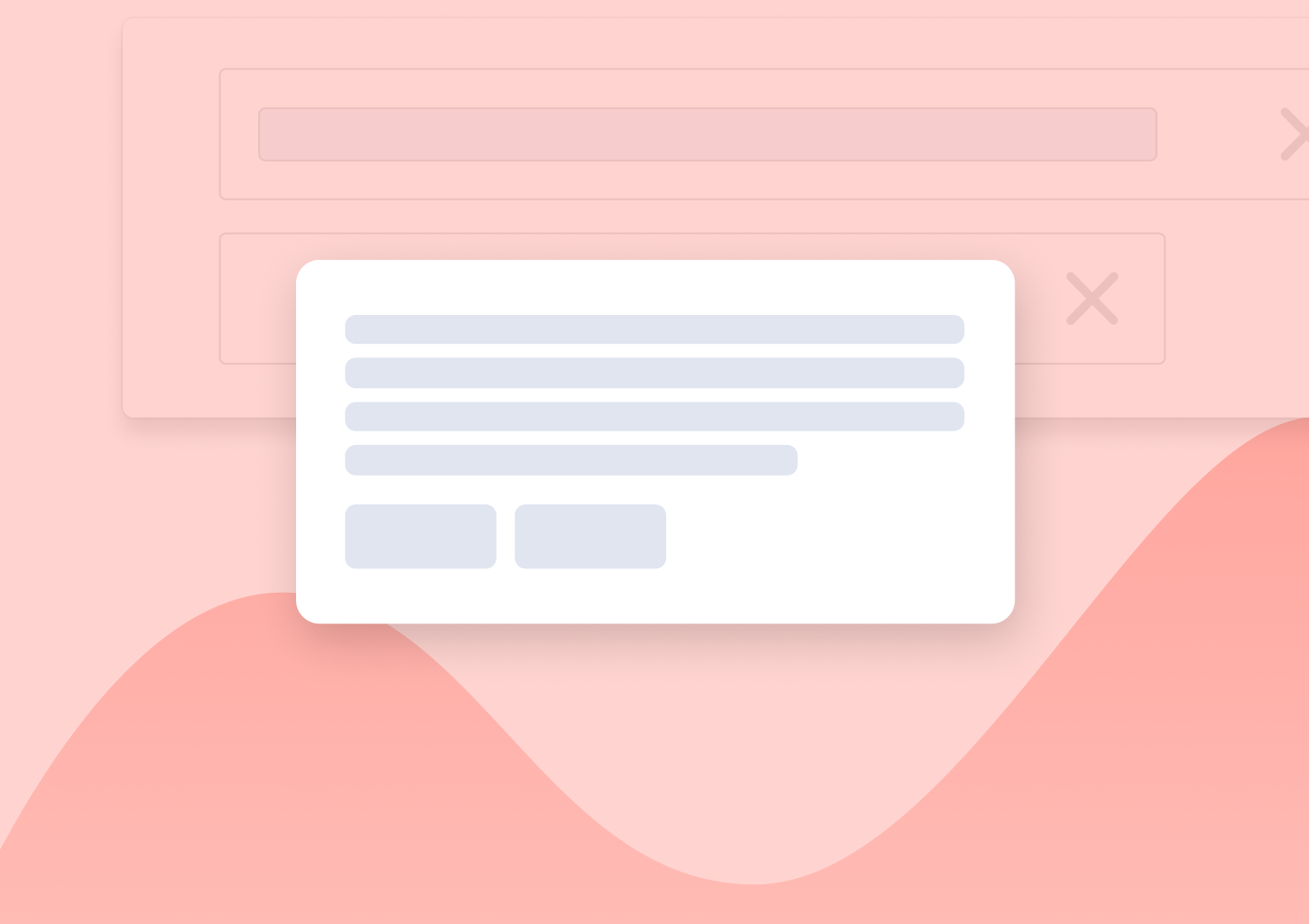The Ultimate Guide to Product Surveys
Do you plan to collect feedback about your product but feel that user interviews are just too time-consuming? Wondering whether product surveys are the way to go?
As a SaaS founder myself, I know very well that there is absolutely no better way to increase your product’s value is to listen to your customers.
In fact, customers are the only people who can tell you the truth about your product. No one else has such a deep interest in it as the people who use it to solve their problems. To everyone else you ask, your product is just another tool they see. But for customers, it’s often something that crosses the line between stress and peace of mind.
But there lies a problem – How to collect this feedback at scale, without having to spend countless hours on customer interviews?
The solution – Product surveys.
Product surveys make the sweet spot between analytics tools and user interviews to help you make great product decisions.
This guide looks at everything you need to know about product surveys, the different types you can run, their use cases, and the tools you can use.
So, let’s begin.
What Are Product Surveys
A product survey is a survey you send to segments of your audience to gather their feedback about your product.
For example, you can run a product survey to your most loyal users to find out what they like about your product and what you can improve.
You can also run a product survey to the users who are about to churn to spot any patterns on the reasons they stop using your product.
Product surveys allow you to access real data to shape your product roadmap based on what your audience really needs.
But unlike user testing which can take months, product surveys give you access to valuable insights in just a few seconds.
In the bigger scheme of things, Product Surveys are part of User Surveys as outlined in the video below:
Types of Product Surveys
There are many types of product surveys you can run, and they all depend on the reasons you want to create them.
Each type can help you gather different insights and if you are using Refiner, there are unique product survey templates that you can use for all of them.
Here are the different types of product surveys you can launch.
Net Promoter Score (NPS) survey

NPS surveys help you discover the likelihood of a user recommending your product to a friend. They are measuring customer loyalty and the rating is on a scale of 0-10.
Naturally, you want to have as many users as possible closer to 10 but NPS it’s not just about the number, though. With NPS surveys you can identify your most loyal users and create a new segment that can help you shape your product roadmap when needed.
Customer Effort Score (CES) survey

CES surveys are measuring the effort your users make when using your product or service.
Whether it’s about signing up for your product or interacting with your customer success team, every touchpoint can affect their CES score.
CES surveys shouldn’t take long for users to answer. You can even launch one question that your users can answer using emoji to express their level of satisfaction while using your product.
The goal is to provide a smooth product experience to remove any friction that can lead to churned users.
Customer Satisfaction (CSAT) survey

A customer satisfaction survey helps you understand your users’ level of satisfaction.
CSAT surveys should be simple and easy to answer and you can add follow-up questions to dive deeper into the key responses.
For example, you can ask
“How satisfied are you with our product?”
The user can pick a range from ‘very unsatisfied’ to ‘very satisfied’. The response is quick and direct but you can still add a follow-up question to understand what they like (or don’t like) in your product.
Product Market Fit (PMF) survey
PMF surveys can help you measure how close you are to reaching product-market fit for a segment of your audience.
They can help you validate your assumptions and improve your insights about your users.
A PMF survey question could be:
“How would you feel if you could no longer use our product?”
The responses range from ‘very disappointed’ to ‘not disappointed’ and the findings can improve your segmentation and understanding of your customers.
Feature opt-in survey
A feature opt-in survey helps you improve your product roadmap by discovering the most important features for your users.
You can trigger a micro survey to the most engaged users to ask them how they feel about a certain feature.
Improve your product marketing by making the most of the learnings and always providing the right context to maintain a high response rate among your users.
You don’t want to ask a user who just signed up how they feel about a feature, do you?
Beta feedback survey
Interested in collecting feedback from your customers about a new product or service? Market research is crucial but there are also times when you need a quicker response.
Launch a beta feedback survey to the right audience in the most contextual way to find out what your engaged users think about your new features or a potential addition.
You can ask your target audience about the user experience, whether the feature addresses their pain points, or if the feature adds anything to their daily use.
Use the insights to shape your offering and let the product marketing and customer service teams be as prepared as possible for the launch.
Churn feedback survey
You’re noticing a user is about to stop using your product. It’s time to find out what led them to this decision.
A churn feedback survey makes the process of collecting feedback easier for users who are about to churn. The more insights you collect, the easier it becomes to spot any patterns that affect your product’s growth.
Ideally, you want to launch a churn feedback survey at the right time. It has to be simple and easy to answer so that you maintain a high response rate. Be direct with a multiple choice question and ask about the reasons they stopped using your product.
If you want to find out more about their decision, you can add an open-ended follow-up question.
Persona identification survey
How about using a product survey to gather audience insights? A persona identification survey can help you understand how your customers use your product and what you can learn from them.
You can ask them an open-ended question about the pain points that the product is solving.
Or you can use a multiple-choice question to learn about their role in their company. Do they work in product or marketing? How senior is the role?
The results may be different from what you assumed up to now.
When to Use a Product Survey
There are many ways to use a product survey and it all comes down to your objectives.
Let’s look at the different moments to launch a product survey.
#1. Feature requests
Product surveys make it easier for your users to submit their feature requests, especially when they are triggered at the right time.
You can even ask just one question to give your most engaged users the space to express their thoughts on what they are missing from your product.
#2. Qualify signups

If you want to learn more about your new users, you can use product surveys to qualify your signups.
Ask them about the industry they are working on, their pain points, or even their level of seniority to confirm what they want from your product. You can also confirm your product-market fit or how interested they are in using your product on a regular basis.
#3. Up-selling opportunities
Once you identify your most engaged users, you can trigger a product survey to explore whether they are interested in any upgrades.
The survey should be focusing on solving the users’ problems. For example, you can ask them about the number of team members using your product, how they are finding it or what they are missing from your product.
Based on their responses, you can ask them whether they are interested in trying an upgrade that can solve any of the pain points they already mentioned.
#4. Prevent churn
You can launch a product survey to the segment that is about to churn to find out more about their concerns.
In this case, it’s all about the context and triggering the survey at the right time. You don’t want to launch a survey too early or too late when they already know they’ll stop using your product.
Help your users engage with your product again and gather valuable feedback by asking the right questions.
#5. Nurturing
Product surveys can facilitate lead nurturing and get your new customers to understand the value of your product.
By launching them at the right time you can make it easier for others to get into the “a-ha moment” where they understand what they can get out of your product or service.
For example, you can launch a CES survey to measure the customer effort after the signup or you can add a follow-up question to see what they are missing from the initial product experience.
#6. User research
Not all validations require months of research. Product surveys can help you get quick answers in the most contextual way.
You can run surveys throughout the lifecycle of your customers to follow their evolutions and collect all the insights to improve your product roadmap.
For example, you can trigger a quick multiple-choice question to ask your engaged users about their favorite feature.
#7. Building personas
Product surveys can help you strengthen your understanding of your audience. You can also use them to learn more about segments of your audience that may be new to you to build the right marketing personas.
For example, you can launch a product survey to confirm the most popular industries for your users or how they discovered your product.
The more you’re learning about your audience, the easier it will be to use the right messaging for them.
#8. Reviewing the product roadmap
A product manager can’t shape the product roadmap without customer feedback. That’s when product surveys come in handy.
You can launch a quick product survey to confirm whether your upcoming features are useful for your users. If your users disagree, it’s time to add a follow-up question on what they’d like to see instead.
6 Tools to Use to Launch a Product Survey
Now that you know all the different moments to launch a product survey, it’s time to explore the best tools to create effective product feedback surveys.
#1. Refiner – The Complete Product Survey Software for SaaS

Refiner (disclaimer: this is our tool) is a customer feedback and survey platform built specifically for SaaS. It can help you collect feedback and launch product surveys to improve customer satisfaction and shape your product roadmap.
With Refiner, you can:
- Measure customer satisfaction with NPS surveys, CSAT, and CES surveys
- Access survey templates that you can fully customize to your branding
- Collect data to improve your product roadmap
- Import your own data from other sources to strengthen your insights
- Deliver surveys as widgets, in-app widgets, emails, or a survey link
- Personalize your surveys based on the responses
- Visualize data in real-time on the dashboard
Pricing: There is a 14-day free trial while the Essentials plan starts from $99/month.
Want to see Refiner in action? Check out the live demo now.
#2. Qualtrics

Qualtrics is a powerful customer experience management software. It can help you improve customer engagement by listening to your customers and reaching them at different points.
You can gather real-time feedback with 27 channels and 128 data sources all feeding into their platform. Feedback can range from videos with emotion analytics to website feedback or sentiment on social media channels.
For some people, Qualtrics feels complicated to use and it’s not exclusively focused on SaaS.
Pricing: It depends on the products you’ll use but be prepared to set some budget aside for this.
#3. GetFeedback

GetFeedback is a customer experience platform that helps you collect in-the-moment feedback across various channels such as email, SMS, website, and mobile apps.
You can quickly launch NPS surveys, manage feedback touchpoints and trigger surveys at the right time for the right audience.
Its strong integration with Salesforce allows you to track customer data in real-time while you can also integrate it with tools such as Google Analytics, Slack, Zendesk, JIRA, etc.
Pricing: You need to contact their Sales team to find out more.
#4. SurveyMonkey

SurveyMonkey is one of the most popular survey platforms out there. It’s simple and you can use it as a quicker alternative to time-consuming market research options.
You can run various types of surveys for customer feedback, engagement, product feedback, employee satisfaction and even academic research surveys.
It may not be built exclusively for SaaS but it’s still a good all-around option with affordable pricing.
Pricing: The basic individual plan starts at $20/month while the team plans start from $32/user per month
#5. TypeForm

Typeform is a popular survey platform to collect feedback from businesses of all sizes. It helps you create surveys for various uses but also polls and quizzes to ensure you’re on track with your customer feedback.
Its user-friendly interface makes it easy to create a personalized survey in just a few minutes and you can also access various templates for the product, customer success or customer satisfaction.
It’s a good tool for all sorts of uses around feedback gathering that many brands trust, though it’s not exclusively focusing on SaaS businesses.
Pricing: The Basic plan starts from $25/month.
#6. Survicate

Survicate is a customer survey tool that makes it easier to collect customer feedback to improve acquisition, engagement, and retention.
You can use it to build, distribute, and analyze your surveys while you can trigger surveys based on specific events such as exit intent, time delays, and custom triggers.
It’s a great tool for small to medium-sized businesses but it’s more of a general tool than one focusing on SaaS.
Pricing: There is a free plan while the Basic plan starts from $79/month.
Examples of Product Survey Questions
What kind of questions should you ask in a product survey?
Let’s look at some examples based on the different types of product surveys you can launch.
How likely are you to recommend X product to a friend or colleague?
This is a question to measure your NPS and the likelihood of your audience to recommend your product to others. It’s an important question to see where you stand in customer loyalty and what you need to improve if the score is not what you expected.
How satisfied are you with our product?
This is a CSAT survey question to measure customer satisfaction with your product. You can launch it to your most engaged users or segment your audience, even more, to explore how different personas feel about your product.
How easy was using our product so far?
This is a common CES survey question to help you measure customer effort. It should give you an indication of how your customers feel about the level of effort when using your product and you can also add follow-up questions to find out more about their answers.
What problems do you try to solve with our product?
Understanding your audience’s pain points can help you shape your personas. Use this question as part of persona identification to dive deeper into your audience’s needs and what you need to improve in your product.
How can we improve our product?
Ask your most engaged customers what they think about your product and what you need to improve. You can launch this survey in an open-ended format or you can provide multiple choices to guide them through the process.
How often do you use our product?
Ask this question to learn more about your users’ product habits. Launch the survey to different segments of your audience to compare their frequency of use and how it translates to their overall level of engagement.
That’s it…
Everything you need to know about product surveys in one guide.
There are many ways to use a product survey.
All you need is a plan based on your objectives and your target audience for each survey.
After all, it’s all about the user experience.
Good luck with launching your next product survey!
Want to see how Refiner helps you launch product surveys for your SaaS? Check out the live demo now. No signup necessary.








